Nicholas Lewis
On Moderation
Thats both the beauty and ugly side of having a BiMode fleetBecause of IRP etc it will go ahead. However the treasury will want to break the scheme into a gazzilion portions and approve each bit.
Thats both the beauty and ugly side of having a BiMode fleetBecause of IRP etc it will go ahead. However the treasury will want to break the scheme into a gazzilion portions and approve each bit.
Thanks for the update!The latter 2 quartets.
Gralistair's post makes very interesting reading £1.3 Billion for electrification to Sheffield - 422 track miles. 3 major stations and 120 bridges modified.....and stopped due to cost at that time I presume. Which puts HS2 at what, 100 times that cost, into perspective!
Anyway, I went out in the sunshine today, and there have been a few more cantilevers installed in the country sections. No significant piling or masts through Desborough. Lots of workers starting foundation work ( well, there are steel reinforcement "cages" etc in view) at Harborough Station on the West side.
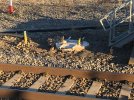
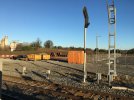
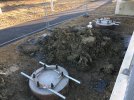
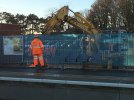
I'm curious about this photo - obviously the normal distance between OHLE masts is >50m, so can any of our resident electrification experts comment on why you'd have 2 structures so close together?
In summary, the Market Harborough situation seems to be
- A number (perhaps 5) masts North of the station
- piles being installed behind the platforms
- one mast immediately south of the station, then
- a gap of about 200m
- one TTC just South of the River Welland bridge
- one TTC by ATS tyres (Kettering Road)
- a gap of about 275m, then
- About 8 TTCs in various states of completion, 4 North and 4 South of the Glebe road footbridge
- some STCs where the railway runs directly next to Braybooke Road,
Then little, if any steelwork at least to the Braybrooke substation.
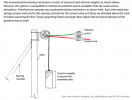
Not quite; UKMS (but yes, Tensorex vice weights, although both are available). The closely spaced foundations are indeed for a Series 1 (UKMS 140) 'monoboom' anchor, and will either take Tensorex or a half-tension fixed anchor.Are they using "Series 1" type equipment with Tensorex springs et al rather than weights...?
Generally, yes - although renewals in areas of existing are increasingly adopting Siemens' anti-fall weights first debuted on the WCRM. Kings Cross used a couple in the Belle Isle area during the recent modernisation; the Stratford area wire renewals used a few, and there are a few in the Stockley Jn area on the GWML when the junction was remodelled for the advent of Crossrail.Am I right in thinking that no lines electrified in recent years have used weights and pulleys?
Grayling essentially told NR the CP5 budget was capped and not to use their borrowing powers to avoid the cap.Yes that is interesting and given ECAM process was quite in depth, well was on a project I was on at the time, that ought to have given DofT certainty over project costs which had at that stage increased by 25% to 1.3B. It was then several years after this that Grayling pulled the plug and whether there had been more cost creep isn't clear so was it just by association with the ongoing GWEP debacle everything else got pulled I guess.
Perhaps when RNEP finally gets updated we will get an indication of what the project will cost now.
How much though, seeing as Nottingham will get HS2 trains?Now with no Eastern leg of HS2. The MML BCR has gone up again.
I don't understand how a BCR (Benefit Cost Ratio) can be negative?
What is a "negative benefit" though and how does it differ from a cost?quite easily, negative benefits and positive costs. Some reopenings are in this territory.
Isn't it the other way round? Cost savings (at Net Present Value over the appraisal period) were greater than the capital cost plus the NPV of the extra operating costs.quite easily, negative benefits and positive costs. Some reopenings are in this territory.
in this case, AIUI the MML Business Case was described as cash positive, which means you don’t have a BCR as such.
When they talk "costs" for BCR calculations, they actually mean the total expenditure on the project less the income expected additional ticket sales and from reduced maintenance etc. These numbers are discounted to a Net Present Value (NPV) using standard Discounted Cashflow methods.I don't understand how a BCR (Benefit Cost Ratio) can be negative?
Cracking video, thanks for posting.Don Coffey posted another video - this time a Class 66 cab ride from Bedford to Earles Sidings, taken on 10 August 2021.
We get a clear driver's eye view of the now-operational OHLE between Bedford and Kettering North TSC via the Wymington Deviation, plus the Market Harborough-bound bare masts in Kettering (up to 44:30 in all; no masts any further north at the time). The Braybrooke worksite is to the right of picture about 52 minutes in.
Weren’t the 91’s rumoured to move across to the MML before the electrification got Graylinged?
Weren’t the 91’s rumoured to move across to the MML before the electrification got Graylinged?
No, they were too heavy. Maximum Ra 5 if you wish to go at 125 due to too many weak underbridges.
I was under the impression that Leicester was similar to parts of the Trans Pennine scheme in that they wanted to do the signalling and other infrastructure work at the same time as electrification to avoid rework. Does this mean that reinstating all the lines into Leicester, grade seperation at Wigston etc. has been agreed as well?I was told that they now have the go ahead to Leicester......
I was under the impression that Leicester was similar to parts of the Trans Pennine scheme in that they wanted to do the signalling and other infrastructure work at the same time as electrification to avoid rework. Does this mean that reinstating all the lines into Leicester, grade seperation at Wigston etc. has been agreed as well?
I'm particularly excited to see what form Leicester is expected to take. Do we know when an announcement about this might materialise?no - the remodelling at Leicester will happen first - whatever form it takes.
in this context “To Leicester” almost certainly means “to just south of Wigston Junctions”
The latest information published by Network Rail that I am aware of is the Leicester area strategic advice from July 2020.I'm particularly excited to see what form Leicester is expected to take. Do we know when an announcement about this might materialise?
Yes I am sure I have read that elsewhere too. And with my crayonista hat OFF makes sense too.in this context “To Leicester” almost certainly means “to just south of Wigston Junctions”
